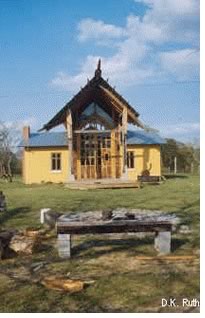

Samuel ‘Sambo’ Mockbee Awarded 2004 AIA Gold Medal Posthumously
 The
AIA Board of Directors on December 4 conferred the Institute’s highest
individual honor, the 2004 AIA Gold Medal, on the late Samuel ‘Sambo’
Mockbee, FAIA, a teacher and practitioner who devoted his life to advancing
socially responsible architecture.
The
AIA Board of Directors on December 4 conferred the Institute’s highest
individual honor, the 2004 AIA Gold Medal, on the late Samuel ‘Sambo’
Mockbee, FAIA, a teacher and practitioner who devoted his life to advancing
socially responsible architecture.
An award-winning architect, Mockbee, widely known as “Sambo,” may be best known for co-founding, with D.K. Ruth, Auburn University’s Rural Studio—conceived as an opportunity to raise the spirits of the rural poor through the creation of homes and community centers designed with the same set of architectural principles as those buildings made for prominent clients with sizeable budgets. The Rural Studio aims to advance “context-based learning” by pairing second-year and fifth-year architecture students, removing them from their college campuses, and placing them to live and work with rural residents as architects and clients. The students design and build homes or other structures, primarily with donated and found materials.
 To
his students, Mockbee presented architecture as a discipline that must
be committed to environmental, social, political, and aesthetic issues.
In a 2001 interview with Architectural
Record, Mockbee said, “These small projects designed by students
at the Rural Studio remind us of what it means to have an American architecture
without pretense. They remind us that we can be awed by the simple as
much as by the complex, and if we pay attention, they will offer us a
simple glimpse into what is essential to the future of American architecture
. . . its honesty.”
To
his students, Mockbee presented architecture as a discipline that must
be committed to environmental, social, political, and aesthetic issues.
In a 2001 interview with Architectural
Record, Mockbee said, “These small projects designed by students
at the Rural Studio remind us of what it means to have an American architecture
without pretense. They remind us that we can be awed by the simple as
much as by the complex, and if we pay attention, they will offer us a
simple glimpse into what is essential to the future of American architecture
. . . its honesty.”
Immediately after the AIA Board’s vote selecting Mockbee for the honor, AIA President Thompson E. Penney, FAIA, called Auburn University College of Architecture, Design, and Construction Dean Daniel Bennett, FAIA, to tell him the news. “His spirit is certainly in the room,” Penney said, “he represented the values that we all hold near and dear to our hearts.”
“This is wonderful news,” Bennett exclaimed, adding that the university will work with the AIA to share Mockbee’s values with the rest of the world. “It is my pleasure to be a part of this,” he said.
 “Shelter
for the soul”
“Shelter
for the soul”
The Gold Medal recognizes an individual whose significant body of work
has had a lasting influence on the theory and practice of architecture.
In nominating Mockbee for the award, AIA Gulf States regional director
and board member Jamie Aycock, AIA, commented, “Sambo and the Rural
Studio he founded have transcended both architectural profession and academy
and have found shelter in the hearts of the populace.” In highlighting
Mockbee’s deep commitment to the community, Aycock says, “He
taught his students that architecture is a discipline deeply rooted in
community, and to embrace his philosophy that everyone, rich or poor,
deserved a ‘shelter for the soul.’”
Mockbee practiced privately for many years prior to embarking on the Rural Studio. After completing his internship in 1977, he founded Mockbee Goodman Architects with friend and classmate Thomas Goodman. The firm quickly built a regional reputation for utilizing local materials in the exceptional designs, winning more than 25 state and regional awards in four years. After parting with Goodman, Mockbee continued to build on his reputation by forming a partnership with Coleman Coker in the early 1980s.
 During
that time, Mockbee, a fifth-generation Mississippian, was hailed as one
of the nation’s premier regionalists and an important new voice
of the South. Mockbee Coker Architects was known for challenging the classic
processes and definitions in the creation of architecture, documented
in their 1995 monograph, Mockbee Coker:
Thought and Process (Princeton Architectural Press). While working
with Coker, Mockbee continued to investigate the social, economic, and
cultural inconsistencies that he saw permeating the South. Out of his
observations grew a mission and plan for the Rural Studio.
During
that time, Mockbee, a fifth-generation Mississippian, was hailed as one
of the nation’s premier regionalists and an important new voice
of the South. Mockbee Coker Architects was known for challenging the classic
processes and definitions in the creation of architecture, documented
in their 1995 monograph, Mockbee Coker:
Thought and Process (Princeton Architectural Press). While working
with Coker, Mockbee continued to investigate the social, economic, and
cultural inconsistencies that he saw permeating the South. Out of his
observations grew a mission and plan for the Rural Studio.
 A
“genius”
A
“genius”
For his work with the Rural Studio and his architecture, Mockbee received
many grants and awards including the prestigious John D. and Catherine
T. MacArthur Fellow “Genius Award” (2000); Mississippi Governor’s
Lifetime Achievement Award for Artistic Excellence (2000); several AIA
Honor Awards (1995, 1994, 1982); and the Apgar Award For Excellence (1999).
His work has been exhibited in several galleries and museums, including
The Whitney Museum of American Art, New York City (2002); the Museum of
Modern Art, New York City (1998); and the Smithsonian’s Cooper-Hewitt,
National Design Museum, New York City (2000).
 Mockbee
died in December 2001 of complications from leukemia. However, even as
he was being treated for the debilitating illness, he continued to work
with his students, as they researched low-cost building materials, and
sketched his vision for the redevelopment of the World Trade Center site,
which was included with 60 other designs at the Max Protecht Gallery in
New York City.
Mockbee
died in December 2001 of complications from leukemia. However, even as
he was being treated for the debilitating illness, he continued to work
with his students, as they researched low-cost building materials, and
sketched his vision for the redevelopment of the World Trade Center site,
which was included with 60 other designs at the Max Protecht Gallery in
New York City.
Mockbee’s biography describes him as “truly loved and admired by all who came into contact with him. He had an amazing design talent, but his uniqueness came from his compassion for people, especially those who were socially and economically disadvantaged. He cast a spotlight on an aspect of our culture that most avoid . . . and he demonstrated that socially responsible architecture can delight the senses, inspire the masses, and serve the soul.”
Copyright 2003 The American Institute of Architects.
All rights reserved. Home Page ![]()
![]()
 |
||
| Photos © Timothy Hursley Representatives of Samuel Mockbee will be presented with the Gold Medal at the 2004 American Architectural Foundation Accent on Architecture Gala March 3, 2004, at the National Building Museum in Washington, D.C. AIArchitect reflected on Mockbee’s contributions in a January 2002 article. For a review of a book on his work, Rural Studio: Samuel Mockbee and an Architecture of Decency, see this “Summertime Reading” article from last year. The Gold Medal recognizes an individual whose significant body of work has had a lasting influence on the theory and practice of architecture. To honor his legacy to architecture, Mockbee’s name will be chiseled into a granite wall of honor in the lobby of the AIA headquarters in Washington, D.C. As the 60th recipient of the award, his name joins the ranks of such visionaries as Thomas Jefferson, Frank Lloyd Wright, Louis Sullivan, Le Corbusier, Louis Kahn, I.M. Pei, Cesar Pelli, and 2002 AIA Gold Medal recipient Japanese architect Tadao Ando.
|
||